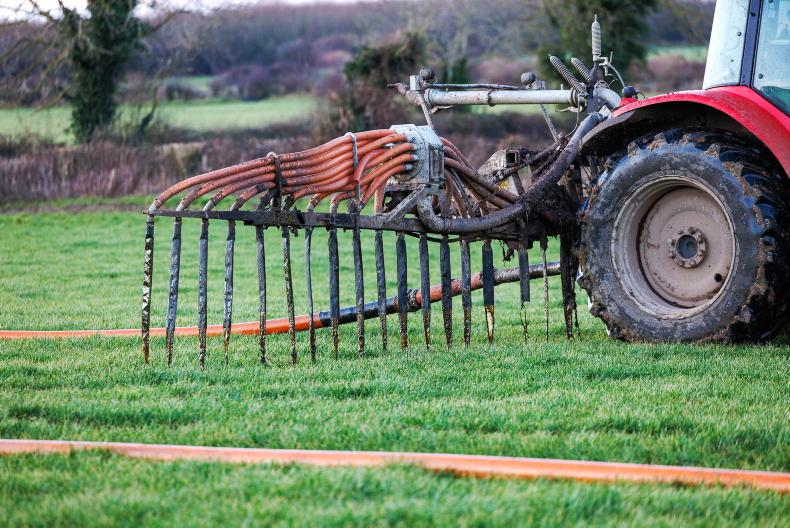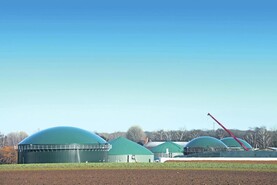Ireland’s biomethane sector has been poised for takeoff for what feels like decades. But while its value as a renewable fuel is generally accepted across energy, climate and agriculture circles, clear policy direction, particularly around market creation, has yet to materialise.
Speaking to the Irish Farmers Journal, renewable energy lead for advisory firm Interpath in Ireland, Gary Borland said that despite strong interest, especially from developers and funders, momentum has stalled due to policy delays.
“We have to do this now,” he said, referencing both the energy and agricultural benefits of biomethane. “It’s not just about energy security and decarbonisation.”

Gary Borland.
More than a molecule
Gary Borland (inset), who spent over 20 years at KPMG and advised on the development of the National Biomethane Strategy, said that biomethane’s real value extends beyond energy and climate, into farming and rural development.
“For too long the focus has been on biomethane as a renewable energy source that’s really expensive. Yes, but we’re forgetting the fact that it brings so many other benefits,” he said.
He said that developing an anaerobic digestion sector could contribute to better nutrient management on farms and ultimately help improve water quality and the sustainability of farming.

Borland maintains that AD can improve the sustainability of agriculture while allowing farmers to continue producing food.
Farmers locked out
However, in the initial phase of AD development, farmers will be largely locked out of building their own plants, as the emerging market structure favours large-scale developers who can achieve economies of scale across planning, technology and grid costs.
It’s not going to be like Northern Ireland, which had a clear, well-defined support scheme that favoured smaller plants. Borland said that while a similar feed-in-tariff style of support would have been much more straightforward here, that was ruled out.
Instead, we will see a market obligation introduced, the Renewable Heat Obligation (RHO), which will mandate fuel suppliers to mix biomethane or other renewable fuels into their fuel mix. Farmers will still play an important role in feedstock supply and digestate use, however.
RHO delay
Details are expected before the Dáil’s summer recess on the long-promised RHO, Ireland’s main proposed route to market for biomethane, but as I write this, it remains unclear if that will happen.
Repeated delays of this policy have created uncertainty for developers and investors. While a small number of projects have moved forward, largely with voluntary corporate gas purchase agreements, there is simply no functioning market to support investment at the scale needed to meet national targets, Borland explained.
Without the RHO in place, Irish developers are struggling to secure gas offtake contracts that underpin funding. This, Borland explained, makes it hard to convince infrastructure investors to commit capital. “You’re asking them to take just too much of a leap of faith,” he explained.
While this is frustrating, Borland is positive that the RHO will happen.
“No one is saying it won’t happen. No one is saying the RHO is going to be scrapped and rewritten. No one,” he said.
Investor confidence
Borland explained that, in some cases, international funds with experience in biomethane have begun to walk away from Irish projects due to a lack of policy clarity, opting instead for more predictable opportunities in mainland Europe.
He reported that while Ireland isn’t necessarily seen as higher risk, the protracted timelines, planning hurdles and high connection costs increase overall project cost and complexity. This in turn raises the price developers need to achieve for gas, making Irish biomethane significantly more expensive than imported equivalents, likely in the €120 to €160 per MWh range, compared to €80 to €100 in parts of Europe.

Digestate management is key to a sustainable AD sector.
Small-scale
However, he explained that at a small scale, innovation and technology could make it feasible for farmers to develop their own projects.
Although smaller plants typically face proportionally higher costs, such as for grid connection and gas cleanup, and often require higher gas prices to be viable, this may change as the industry matures.
With clustering, once the industry is established, it could become possible for farmers to participate, he said.
“If you start compressing raw biogas and transporting it from two, three or even four small plants to one cleanup and grid injection point, all of a sudden the smaller plants could become cost-effective and therefore they could compete with the larger plants in terms of the gas price that they need,” he said.
Planning and perception
Public and local opposition has emerged as a serious barrier to new AD developments, with several large projects facing community backlash.
Borland emphasised that, from his clients’ perspective, early engagement and clear, transparent communication, including demonstrating community benefits, are essential.
When asked whether some of the hostility within agriculture towards AD stems from early Government messaging that linked biomethane to livestock reductions and land use changes, he replied: “Any time anyone mentions destocking, it is a very emotive topic, and rightly so.”
Still, Borland maintained that AD can improve the sustainability of agriculture while allowing farmers to continue producing food.
Grants welcome, but not reliable
While a new round of capital funding is expected next year, Borland said developers are treating it with caution.
The last DAFM-led round offered 20% capital support, but uncertainty around timing and terms makes it difficult to rely on, he explained.
As a result, most investors and developers are modelling projects without factoring in grants, viewing them as helpful if they materialise but not critical.
“Until you have that grant and until you have it paid, I think people are treating it with a degree of caution,” he said.
The next round of funding, while not confirmed, is rumoured to be upwards of €300 million.
Northern Ireland next steps
In Northern Ireland, the anaerobic digestion sector, which produces electricity, matured much earlier than the Republic, with nearly 100 small plants built under government support.
While some of these plants will soon face the end of their 20-year subsidy scheme, they may be in a position to convert to biomethane if support mechanisms are introduced.
Borland said that some existing plants could be extended or repurposed at lower cost, but that policy in the North remains behind the Republic in terms of formal biomethane strategy. “They’ll be starting to think about what the next three, four, five years look like,” he said.
The path forward
According to Borland, the future of Ireland’s biomethane sector will depend heavily on how and when the RHO is finalised.
The obligation must send a strong enough price signal to support indigenous production and ensure that utilities do not rely solely on cheaper imported renewable gas, he said.
“The RHO of itself is fundable,” he said. “But we still don’t know the final detail. If the final design isn’t right, we might be back to where we started,” he said.
The author Stephen Robb is currently involved in a family/community proposal for an anaerobic digestion facility in Co Donegal.
Ireland’s biomethane sector has been poised for takeoff for what feels like decades. But while its value as a renewable fuel is generally accepted across energy, climate and agriculture circles, clear policy direction, particularly around market creation, has yet to materialise.
Speaking to the Irish Farmers Journal, renewable energy lead for advisory firm Interpath in Ireland, Gary Borland said that despite strong interest, especially from developers and funders, momentum has stalled due to policy delays.
“We have to do this now,” he said, referencing both the energy and agricultural benefits of biomethane. “It’s not just about energy security and decarbonisation.”

Gary Borland.
More than a molecule
Gary Borland (inset), who spent over 20 years at KPMG and advised on the development of the National Biomethane Strategy, said that biomethane’s real value extends beyond energy and climate, into farming and rural development.
“For too long the focus has been on biomethane as a renewable energy source that’s really expensive. Yes, but we’re forgetting the fact that it brings so many other benefits,” he said.
He said that developing an anaerobic digestion sector could contribute to better nutrient management on farms and ultimately help improve water quality and the sustainability of farming.

Borland maintains that AD can improve the sustainability of agriculture while allowing farmers to continue producing food.
Farmers locked out
However, in the initial phase of AD development, farmers will be largely locked out of building their own plants, as the emerging market structure favours large-scale developers who can achieve economies of scale across planning, technology and grid costs.
It’s not going to be like Northern Ireland, which had a clear, well-defined support scheme that favoured smaller plants. Borland said that while a similar feed-in-tariff style of support would have been much more straightforward here, that was ruled out.
Instead, we will see a market obligation introduced, the Renewable Heat Obligation (RHO), which will mandate fuel suppliers to mix biomethane or other renewable fuels into their fuel mix. Farmers will still play an important role in feedstock supply and digestate use, however.
RHO delay
Details are expected before the Dáil’s summer recess on the long-promised RHO, Ireland’s main proposed route to market for biomethane, but as I write this, it remains unclear if that will happen.
Repeated delays of this policy have created uncertainty for developers and investors. While a small number of projects have moved forward, largely with voluntary corporate gas purchase agreements, there is simply no functioning market to support investment at the scale needed to meet national targets, Borland explained.
Without the RHO in place, Irish developers are struggling to secure gas offtake contracts that underpin funding. This, Borland explained, makes it hard to convince infrastructure investors to commit capital. “You’re asking them to take just too much of a leap of faith,” he explained.
While this is frustrating, Borland is positive that the RHO will happen.
“No one is saying it won’t happen. No one is saying the RHO is going to be scrapped and rewritten. No one,” he said.
Investor confidence
Borland explained that, in some cases, international funds with experience in biomethane have begun to walk away from Irish projects due to a lack of policy clarity, opting instead for more predictable opportunities in mainland Europe.
He reported that while Ireland isn’t necessarily seen as higher risk, the protracted timelines, planning hurdles and high connection costs increase overall project cost and complexity. This in turn raises the price developers need to achieve for gas, making Irish biomethane significantly more expensive than imported equivalents, likely in the €120 to €160 per MWh range, compared to €80 to €100 in parts of Europe.

Digestate management is key to a sustainable AD sector.
Small-scale
However, he explained that at a small scale, innovation and technology could make it feasible for farmers to develop their own projects.
Although smaller plants typically face proportionally higher costs, such as for grid connection and gas cleanup, and often require higher gas prices to be viable, this may change as the industry matures.
With clustering, once the industry is established, it could become possible for farmers to participate, he said.
“If you start compressing raw biogas and transporting it from two, three or even four small plants to one cleanup and grid injection point, all of a sudden the smaller plants could become cost-effective and therefore they could compete with the larger plants in terms of the gas price that they need,” he said.
Planning and perception
Public and local opposition has emerged as a serious barrier to new AD developments, with several large projects facing community backlash.
Borland emphasised that, from his clients’ perspective, early engagement and clear, transparent communication, including demonstrating community benefits, are essential.
When asked whether some of the hostility within agriculture towards AD stems from early Government messaging that linked biomethane to livestock reductions and land use changes, he replied: “Any time anyone mentions destocking, it is a very emotive topic, and rightly so.”
Still, Borland maintained that AD can improve the sustainability of agriculture while allowing farmers to continue producing food.
Grants welcome, but not reliable
While a new round of capital funding is expected next year, Borland said developers are treating it with caution.
The last DAFM-led round offered 20% capital support, but uncertainty around timing and terms makes it difficult to rely on, he explained.
As a result, most investors and developers are modelling projects without factoring in grants, viewing them as helpful if they materialise but not critical.
“Until you have that grant and until you have it paid, I think people are treating it with a degree of caution,” he said.
The next round of funding, while not confirmed, is rumoured to be upwards of €300 million.
Northern Ireland next steps
In Northern Ireland, the anaerobic digestion sector, which produces electricity, matured much earlier than the Republic, with nearly 100 small plants built under government support.
While some of these plants will soon face the end of their 20-year subsidy scheme, they may be in a position to convert to biomethane if support mechanisms are introduced.
Borland said that some existing plants could be extended or repurposed at lower cost, but that policy in the North remains behind the Republic in terms of formal biomethane strategy. “They’ll be starting to think about what the next three, four, five years look like,” he said.
The path forward
According to Borland, the future of Ireland’s biomethane sector will depend heavily on how and when the RHO is finalised.
The obligation must send a strong enough price signal to support indigenous production and ensure that utilities do not rely solely on cheaper imported renewable gas, he said.
“The RHO of itself is fundable,” he said. “But we still don’t know the final detail. If the final design isn’t right, we might be back to where we started,” he said.
The author Stephen Robb is currently involved in a family/community proposal for an anaerobic digestion facility in Co Donegal.









 This is a subscriber-only article
This is a subscriber-only article










SHARING OPTIONS: